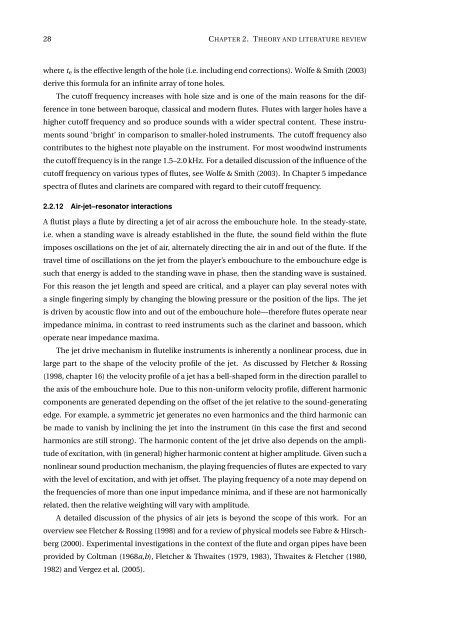Flute acoustics: measurement, modelling and design - School of ...
Flute acoustics: measurement, modelling and design - School of ...
Flute acoustics: measurement, modelling and design - School of ...
Create successful ePaper yourself
Turn your PDF publications into a flip-book with our unique Google optimized e-Paper software.
28 CHAPTER 2. THEORY AND LITERATURE REVIEW<br />
where t e is the effective length <strong>of</strong> the hole (i.e. including end corrections). Wolfe & Smith (2003)<br />
derive this formula for an infinite array <strong>of</strong> tone holes.<br />
The cut<strong>of</strong>f frequency increases with hole size <strong>and</strong> is one <strong>of</strong> the main reasons for the difference<br />
in tone between baroque, classical <strong>and</strong> modern flutes. <strong>Flute</strong>s with larger holes have a<br />
higher cut<strong>of</strong>f frequency <strong>and</strong> so produce sounds with a wider spectral content. These instruments<br />
sound ‘bright’ in comparison to smaller-holed instruments. The cut<strong>of</strong>f frequency also<br />
contributes to the highest note playable on the instrument. For most woodwind instruments<br />
the cut<strong>of</strong>f frequency is in the range 1.5–2.0 kHz. For a detailed discussion <strong>of</strong> the influence <strong>of</strong> the<br />
cut<strong>of</strong>f frequency on various types <strong>of</strong> flutes, see Wolfe & Smith (2003). In Chapter 5 impedance<br />
spectra <strong>of</strong> flutes <strong>and</strong> clarinets are compared with regard to their cut<strong>of</strong>f frequency.<br />
2.2.12 Air-jet–resonator interactions<br />
A flutist plays a flute by directing a jet <strong>of</strong> air across the embouchure hole. In the steady-state,<br />
i.e. when a st<strong>and</strong>ing wave is already established in the flute, the sound field within the flute<br />
imposes oscillations on the jet <strong>of</strong> air, alternately directing the air in <strong>and</strong> out <strong>of</strong> the flute. If the<br />
travel time <strong>of</strong> oscillations on the jet from the player’s embouchure to the embouchure edge is<br />
such that energy is added to the st<strong>and</strong>ing wave in phase, then the st<strong>and</strong>ing wave is sustained.<br />
For this reason the jet length <strong>and</strong> speed are critical, <strong>and</strong> a player can play several notes with<br />
a single fingering simply by changing the blowing pressure or the position <strong>of</strong> the lips. The jet<br />
is driven by acoustic flow into <strong>and</strong> out <strong>of</strong> the embouchure hole—therefore flutes operate near<br />
impedance minima, in contrast to reed instruments such as the clarinet <strong>and</strong> bassoon, which<br />
operate near impedance maxima.<br />
The jet drive mechanism in flutelike instruments is inherently a nonlinear process, due in<br />
large part to the shape <strong>of</strong> the velocity pr<strong>of</strong>ile <strong>of</strong> the jet. As discussed by Fletcher & Rossing<br />
(1998, chapter 16) the velocity pr<strong>of</strong>ile <strong>of</strong> a jet has a bell-shaped form in the direction parallel to<br />
the axis <strong>of</strong> the embouchure hole. Due to this non-uniform velocity pr<strong>of</strong>ile, different harmonic<br />
components are generated depending on the <strong>of</strong>fset <strong>of</strong> the jet relative to the sound-generating<br />
edge. For example, a symmetric jet generates no even harmonics <strong>and</strong> the third harmonic can<br />
be made to vanish by inclining the jet into the instrument (in this case the first <strong>and</strong> second<br />
harmonics are still strong). The harmonic content <strong>of</strong> the jet drive also depends on the amplitude<br />
<strong>of</strong> excitation, with (in general) higher harmonic content at higher amplitude. Given such a<br />
nonlinear sound production mechanism, the playing frequencies <strong>of</strong> flutes are expected to vary<br />
with the level <strong>of</strong> excitation, <strong>and</strong> with jet <strong>of</strong>fset. The playing frequency <strong>of</strong> a note may depend on<br />
the frequencies <strong>of</strong> more than one input impedance minima, <strong>and</strong> if these are not harmonically<br />
related, then the relative weighting will vary with amplitude.<br />
A detailed discussion <strong>of</strong> the physics <strong>of</strong> air jets is beyond the scope <strong>of</strong> this work. For an<br />
overview see Fletcher & Rossing (1998) <strong>and</strong> for a review <strong>of</strong> physical models see Fabre & Hirschberg<br />
(2000). Experimental investigations in the context <strong>of</strong> the flute <strong>and</strong> organ pipes have been<br />
provided by Coltman (1968a,b), Fletcher & Thwaites (1979, 1983), Thwaites & Fletcher (1980,<br />
1982) <strong>and</strong> Vergez et al. (2005).
















